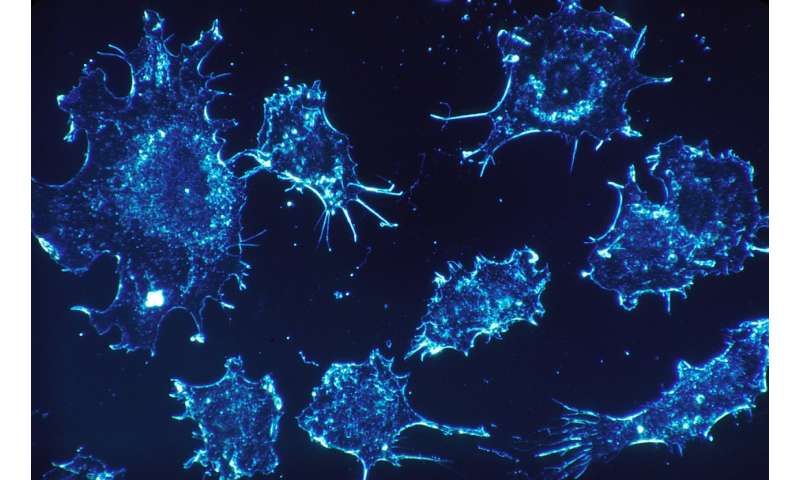Chemotherapy works off of a basic premise: kill all rapidly-growing cells in an effort to wipe out tumor cells. The tactic, while generally effective, has quite a few off-target casualties, including cells that produce hair and cells that line the stomach.
Scientists have tried to skirt the problem by creating missile-like drugs that zero in on cancer cells specifically, sparing healthy cells.
These missile-like drugs, known as antibody-drug conjugates (ADCs), have been in the works for decades, but only in recent years have they made it to clinical trials, Kimberly Tsui, a genetics graduate student, told me.
The advances are at least partially due to a better understanding of how ADCs work: On the surface of every cell are proteins that poke out—some of these proteins are only found on cancer cells, making them a perfect target for tailored drug delivery. ADCs include a shuttle molecule that identifies and clamps down on these cancer-specific proteins, transporting a drug capable of incapacitating the cell.
"ADCs are showing lots of potential in the clinic, but there's a lot we don't understand about how they actually work," said Tsui. "We don't know enough about how ADCs are taken up into the cells, or how the drug is trafficked into different compartments to ultimately kill the cell."
Now, Tsui, Michael Bassik, Ph.D., assistant professor of genetics, and a team of researchers are tapping gene editing to better understand how ADCs deliver their deathly blow to cancer cells.
A study detailing their findings appears in Nature Chemical Biology. Bassik is the senior author. Tsui is the first author. The work was done in collaboration with Carolyn Bertozzi, Ph.D., director of ChEM-H at Stanford.
Bassik and Tsui used the gene-editing technology CRISPR to figure out which genes help ADCs weasel their way into cancer cells.
"With our CRISPR screening system, we can shut off one gene at a time to figure out which ones are important for ADC toxicity," said Tsui. Using this set up, the team is trying to see which genes either help intensify the toxic effect, or conversely, inhibit it.
The idea is to better understand how the ADC interacts with the tumor cell and use the information to make the ADC even more toxic.
"Overall, it starts with basic biology and understanding the genes that could affect ADC toxicity," said Tsui. For example, if a specific gene is "knocked out" or rendered unable to function, and the ADC stops being toxic against the cancer cells, that's a sign that the gene is required for the ADC to become active in the cell. "It could even have important implications for potential ADC-resistance mechanisms," she said.
For an ADC to kill a cell, it has to check a few boxes, most of which are regulated by specific genes. But not all ADCs get into the cell and cause damage through the same mechanism, making it even more critical to understand how ADCs vary when it comes to tumor cell destruction.
It's been thought that all ADCs have to get chopped up, or "digested," before they inflict damage. The understanding was that any ADC binds to the surface of the tumor cell and is taken in through a vessel known as an endosome. The endosome then shepherds the drug to a new compartment of the cell called the lysosome.
There, the ADC gets broken down into its parts, and the drug separates from the antibody shuttle. Then, the drug is moved to yet another new location into the cytosol, the goo that fills the open space of the cell. Here, it can finally do its damage.
Exactly what genes underpin that series of steps, however, is not entirely clear. That's where Bassik and Tsui hoped their screen would come in. Indeed, their experiment revealed a handful of previously unknown genes critical to the trafficking of the drug. In particular, they found that new genes involved in the first stage of endosome-mediated transportation were critical to the success of both varieties of ADCs.
Bassik and Tsui also found evidence to suggest that not all ADCs are digested through the lysosome.
"But the screen revealed genes that implied that the digestion processes happened much earlier, presumably, before the ADC ever even makes it to the lysosome," said Bassik. "Since ADCs can be metabolized in different ways, we see these types of new insights into their mechanism as crucial for future ADC design and development."
Join us on Facebook or Twitter for a regular update.
More information:
C. Kimberly Tsui et al. CRISPR-Cas9 screens identify regulators of antibody–drug conjugate toxicity, Nature Chemical Biology (2019). DOI: 10.1038/s41589-019-0342-2
C. Kimberly Tsui et al. CRISPR-Cas9 screens identify regulators of antibody–drug conjugate toxicity, Nature Chemical Biology (2019). DOI: 10.1038/s41589-019-0342-2
Citation:
Scientists zero in on cancer treatments using CRISPR (2019, August 27)
retrieved 28 August 2019
from https://phys.org/news/2019-08-scientists-cancer-treatments-crispr.html
This document is subject to copyright. Apart from any fair dealing for the purpose of private study or research, no
part may be reproduced without the written permission. The content is provided for information purposes only.
#Biology | https://sciencespies.com/biology/scientists-zero-in-on-cancer-treatments-using-crispr/

No comments:
Post a Comment